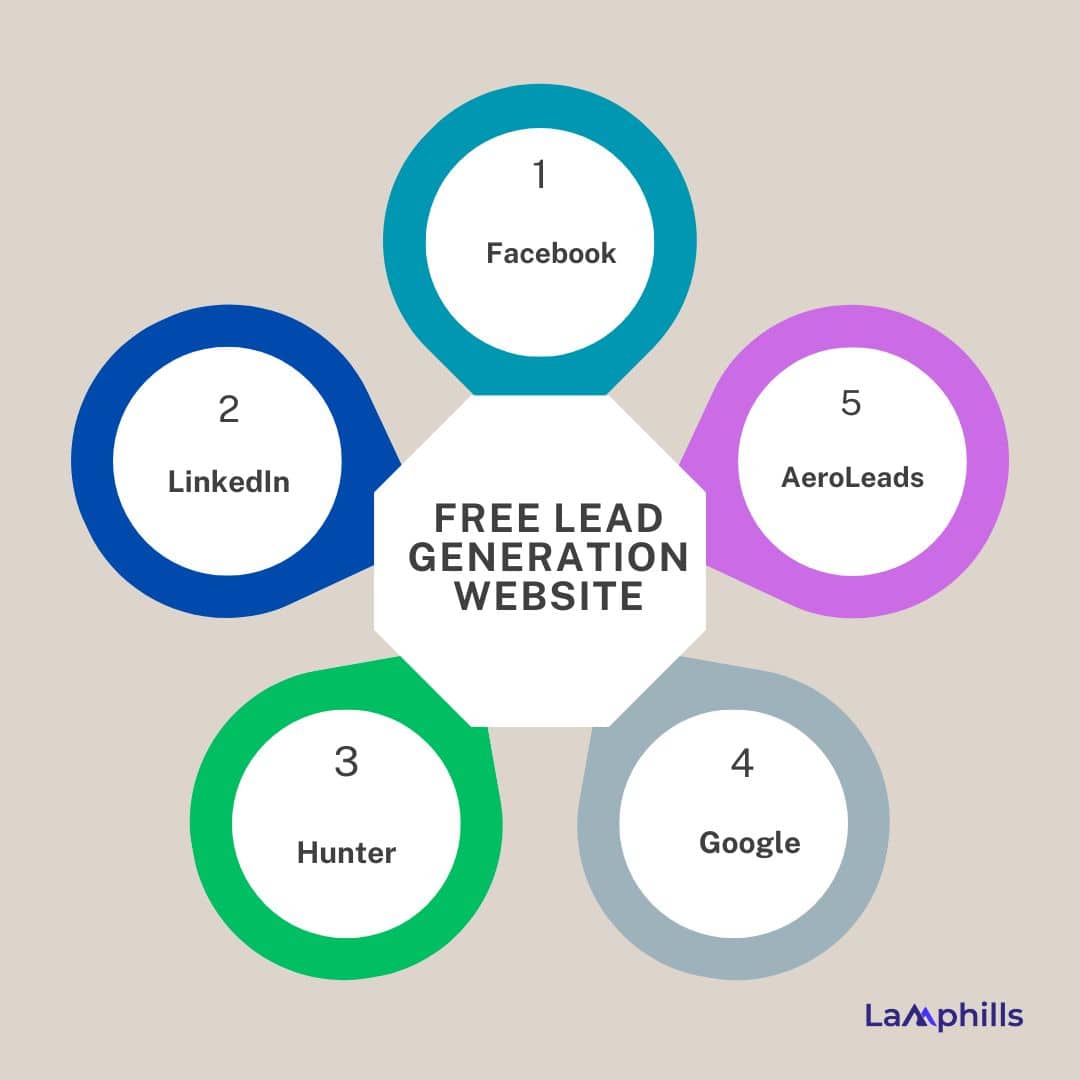For organizations in all industries to succeed in the modern digital environment, lead generation is essential. A strong tool for drawing in new leads, developing them via the sales funnel, and finally turning them into paying customers is an effective website for lead generation. It is not sufficient to have a website; the website must undergo optimization to produce leads that are of a high caliber and yield a sizable return on investment (ROI). How can you design a lead-generation website that generates traffic and a good return on investment? This article will examine free example tools, lead generation tactics, and best practices for building an efficient website.
Key Points
- Conduct in-depth market research and analysis before designing lead generation materials that specifically target their wants and pain points.
- Reduce the complexity of website design by concentrating on the user experience with a simple, mobile-responsive layout and intuitive navigation to improve lead generation.
- It is recommended to utilize calls-to-action that are clear, concise, and actionable to increase conversion rates by directing visitors toward desired actions.
- To enhance the impact of lead generation, create specialized landing pages with messaging that are clear and uncluttered.
- Employ social proof and SEO: To increase lead generation efforts, use case studies and testimonials to establish credibility and improve organic traffic through SEO.
What is a lead generation website?
A lead-generating website is made expressly to transform visitors into potential leads by obtaining their contact information. As an online starting point for your sales funnel, it draws visitors in with offers, content, and forms that encourage them to provide personal information (email address, phone number, etc.) in exchange for something of value (a free resource or consultation, for example).
A lead generation website, in contrast to standard websites that only offer information, is made to turn visitors into leads by encouraging activities such as completing a form, downloading a resource, or making an appointment.
Lead generation website example
The impact of your website on generating leads can be greatly enhanced by using appropriate technologies. Here are a few of the top examples of websites that generate leads:
#1. The Power Framework
With Microsoft cloud services, businesses may manage their projects and operate more productively with the Power Framework Project Management Office (PMO) software. A hands-on sales approach is necessary due to the nature of the business, with a focus on gathering leads to organize website demos.
#2. LawClerk
Thousands of legal companies recruit skilled independent attorneys and part-time associates through the LawClerk online marketplace. In simple terms, LawClerk gives its clients access to a large network of independent attorneys and provides them with easy-to-use tools to communicate with the upon-request attorneys of their choice.
#3. Vye
The marketing firm Vye has locations in Green Bay, Wisconsin, and St. Cloud, Minnesota. Additionally, they have been a longstanding Hubspot partner and can assist companies in leveraging the CRM platform to scale growth. Similar to other firms, Vye uses its website to schedule consultations as a means of generating leads.
#4. The Vinewood Construction
California is home to Vinewood Construction, an all-around contractor. Though they do deal in various fields as well, like painting, flooring, carpeting, plumbing, etc., their clients typically employ them for tenant improvement or general contracting needs. Emails or phone calls made by using their website are what they use to generate leads.
Free Lead Generation Website
Leads are necessary if you intend to expand your business, and free leads are the best kind. To help you obtain a specific number of leads at no cost, I put together the top websites. The following are the top websites for generating free leads:
#1. Facebook
For free, if you already know who you’re looking for, you may utilize Facebook to find email leads online. You may search for certain individuals using their phone numbers in reverse on Facebook. If you are eligible, you can quickly connect with folks because a few may have included their email addresses with their contact details. You may utilize such information to improve your current data because people typically maintain their overall knowledge current and accessible.
#2. LinkedIn
LinkedIn is an additional useful resource for getting free leads. Given enough time, you can utilize it to acquire leads for free, as the majority of professionals use it. LinkedIn lets you search for businesses, job titles, and specific individuals. Searching up your present leads, finding out who they are linked to, and assessing whether they have the potential to become effective leads are more ways to obtain leads.
#3. Hunter
For a restricted period, Hunter is an additional lead generator that provides free leads. By looking through particular industries and businesses, you can utilize the tool to obtain leads through their name and company. The details you acquire will typically be business-oriented because this tool is designed for sales leads.
#4. Google
You can typically obtain free information about businesses by searching them, such as their phone number, contact details, and business profile. Whether you’re looking for leads or not, the majority of businesses, regardless of size, however, own Google profiles that include all the details clients need to know. But only if Google lists your lead does this free service function. It will also probably provide you with the phone number of the company, although it might not have their direct contact details.
#5. AeroLeads
Another tool for generating B2B sales leads that have limited free features is AeroLeads. It is compatible with a Chrome addon that facilitates locating contact details online. AeroLeads may extract contact details from your leads, including phone numbers and email addresses, by using that Chrome extension.

Create a Lead Generation Website
A few years back, I was assigned to design a website that generated leads for a tiny but quickly expanding company. I was somewhat familiar with website design at the time, but lead generation was a foreign idea to me. In retrospect, it was one of the best learning experiences I’ve had in my work, as it showed me how to combine strategy and creativity to produce tangible, actionable outcomes. This is my tale, along with the best strategies I discovered.
Let me explain the fundamentals before going into the actions I took. A lead is anyone who shows concern for the products or services offered by a business. The purpose of a lead-generating website is to obtain visitor information in return for something of value, such as a demo or free resource. Essentially, it’s a technique for converting site visitors into leads who can later be developed into paying clients. I initially set up a simple website for the company, but it was only doing informational stuff. I was unaware of the website’s enormous potential for generating new business until I studied the principles of lead generation.
#1. Recognizing My Audience and Providing Incentives
My initial task was to gain a thorough understanding of the intended audience. This seems much harder than I imagined. I poured hours into analyzing customer data, conducting surveys, and even speaking with prospective customers to learn about their problems and how we could assist in resolving them. It dawned on me that the website ought to concentrate more on providing helpful solutions and less on making sales.
After I was certain of the needs of my target audience, I started developing lead magnets, which were freebies that website visitors could get in return for their contact information. I provided guidelines and whitepapers, as well as a free consultation call, to those who showed the greatest intention. This ended up being the foundation of my lead generation approach. The secret was to provide something genuinely worthwhile, not simply anything at all.
#2. Creating a User-Friendly Website
I went a little overboard with the site’s shiny appearance when I first designed it. Big error. I discovered very soon that user experience and accessibility are crucial for lead generation. Visitors will quit your website before even considering registering for anything if it is busy or complicated. I gave the website a total makeover, emphasizing simplicity and readability. I made sure all of my calls to action (CTAs) were visible, made the homepage simpler, and made it obvious where to go to the most crucial pages. It made a quick difference.
I immediately saw an increase in form submissions in addition to the decline in the bounce rate. Mobile optimization is crucial. The number of visits from mobile devices was something I had not realized at first. Following my correction, lead generation dramatically boosted as the site became mobile-responsive and lightning-fast.
#3. Making Short but Effective Calls to Action
My initial error was using CTAs that were overly ambiguous. “Learn More” and “Contact Us” were among the terms I tried, but they weren’t generating conversions. I concluded that having particular and effective CTAs is essential after doing some research and A/B testing. I changed to CTAs like this in place of ambiguous buttons.
- “Sign Up Now for Your Free Guide.”
- “Get Our Case Study Here.”
- “Make Your Free Appointment Arrangement.”
The effects of these adjustments were significant. When stating your intentions to visitors, be precise and straightforward. Give them no room for guesswork.
#4. Creating Landing Pages That Engage Well
My approach to generating leads now revolves around landing pages. I created a landing page specifically for each new offer we made, such as a webinar, demo, or guide. It appears that maintaining focus on the landing page is important. Simply one message and one action, with no navigation bars or other distractions.
A basic landing page with a striking headline, a succinct summary of the trial’s advantages, and an enrollment form were used, for instance, when introducing a free trial for a recently launched service. Anything that could divert the guest’s attention was removed. That’s why the landing page conversion rates skyrocketed. I have found that doing A/B testing on your landing pages is one of the best pieces of advice I can provide. I tested various form lengths, graphics, and headlines all the time. Conversion rates were sometimes greatly affected by the slightest adjustment.
#5. Using SEO to Increase Organic Visits
I didn’t grasp the importance that organic traffic could add to my lead generation efforts at the time, even though I was familiar with the fundamentals of SEO. By adding keywords, enhancing meta descriptions, and ensuring that the material was worthwhile and applicable to my target, I put in the necessary steps to optimize the website for search engines.
The end outcome? I witnessed an ongoing growth in organic traffic as well as a rise in ranking for important market terms over time. Better yet, since these visitors were searching intently for the answers I provided, they were frequently more involved. I would invest in SEO early if I could go back in time and tell myself one piece of advice. Lead generation is revolutionized by this technique, however, it takes some time to show results.
#6. The Strategic Use of Lead Capture Forms
My forms were first split around the website. Some were hidden away in blog entries, while others appeared on the site. I was, however, not seeing the outcomes I had hoped for. I then understood that my approach to lead capture forms needs to be more planned. However, I shortened the forms and posted them in busy places. I also dabbled with slide-ins and pop-ups, but I discovered the hard way that you shouldn’t use too many of them. Pop-ups that are too frequent bother people. However, they were quite effective when used sparingly, particularly on blog entries that were already receiving a lot of traffic.
#7. Social Proof and Referrals
A buddy once suggested that the website include user reviews. Although I wasn’t initially persuaded, I chose to give it a shot. I updated the home page and landing pages with some case studies and customer testimonials. It had an instantaneous effect. When visitors realized that other people had profited from what we did, they were more likely to register for offers. I realized that social evidence plays a critical role in establishing visitors’ trust. Their likelihood of becoming leads increases if they discover that other people have had good experiences.
How to optimize a website for lead generation?
A deliberate approach is necessary to guarantee that every piece of a website optimized for lead generation motivates visitors to engage in activity. I’ve effectively optimized a website for lead generation, and this is based on my personal experience:
#1. Building a Website for My Own Lead Generation
When I originally started creating lead generation websites, I concentrated on providing genuine value in the form of lead magnets like guidelines that could be downloaded and free consultations. Converting visitors into leads was more important than simply creating an attractive website.
#2. Using Social Proof and SEO
My long-term traffic plan now centers around SEO. My credibility was established by providing case studies and testimonials, along with optimizing for relevant search terms. This significantly raised lead conversions. The benefits outweighed the time investment.
#3. Getting the Most Out of Your Lead Generation
I learned via trial and error how crucial it was to mobile-optimize the website, make navigation simple, and insert forms and CTAs in strategic locations. These minor adjustments significantly raised my conversion rates.
#4. Put Exit-Intent Popups in Place
I used to be afraid of using popups for fear that they might irritate users. Nevertheless, I was able to obtain a sizable number of leads after exploring exit-intent popups, which only showed up when a user was ready to leave the website. I kept visitors who were going to leave without converting by providing a last-minute discount or free resource. These popups turned out to be one of my best instruments for increasing conversions.
#5. Creating Powerful Calls to Action
I started with ambiguous CTAs like “Learn More.” After I made the switch to clear call-to-action CTAs like “Sign Up Now for Your Free Guide” and “Download Free Guide,” the engagement increased dramatically. That small adjustment has a great impact.
#6. Finding of Lead Generation Websites
I studied the architecture of popular lead generation websites like HubSpot and Unbounce when I first started. To build my first website without having to pay anything upfront, I also looked into free products like HubSpot’s free CRM.
#7. Monitor and Evaluate User Activity
I didn’t initially pay adequate focus to user behavior data. However, I discovered important information about how users were interacting with my website once I began utilizing free tools like Google Analytics and Hotjar. I found the pages that needed work and the ones that were functioning well. Better lead generation outcomes resulted from the modifications I made to my content, forms, and CTAs based on this data. Review user behavior frequently, and adjust your approach in light of the information you find there.
#8. Examine and enhance Regularly
You should constantly be improving your website to get leads. My landing pages’ layout, button colors, and headline copy were all constantly tested through A/B testing. My initiatives to generate leads improved over time as a result of my ongoing testing of minor adjustments and evaluation of the effects on conversion rates.
What is the best lead generation website?
The nicest website is the one that is tailored to your target market and business; there isn’t just one “best” lead generation website. Among the most noteworthy instances of effective websites for lead creation are:
- OptinMonster: They are a lead-generating tool provider that employs tutorials, blog posts, and exclusive offers that need users to register to successfully showcase their skills.
- Creating high-converting landing pages is possible with Unbounce.
- HubSpot is well-known for its all-inclusive marketing platform. In exchange for lead data, HubSpot provides many resources, including eBooks, courses, and tools.
- Salesforce: Salesforce creates leads using valuable resources such as case studies, research, and product demonstrations.
- You can maintain leads with software-generated emails by using Mailchimp, an email marketing platform that works well with lead-generating initiatives.
What is the best tool for lead generation?
HubSpot has emerged as my preferred tool for lead management. It provided marketing automation and customer relationship management (CRM) tools that made monitoring lead generation and user behavior simple.
I also utilized OptinMonster to create and test pop-ups and lead-collecting forms. Understanding what works most effectively for the audience became possible in part by the ability to conduct A/B testing.
How to get started with lead generation?
If you’re just getting started, concentrate on these actions:
- Establish your objectives: What kind of leads do you hope to draw in? How can you benefit them in any way?
- Construct a lead magnet: Make an appealing resource or service for your target audience.
- Boost your website’s conversion rate by implementing the best strategies previously discussed to produce landing pages, calls to action, and forms.
- Pick the appropriate instruments: To speed up the lead acquisition process, use solutions such as OptinMonster or HubSpot.
- Evaluate and improve: Keep an eye on the functionality of your website, conduct A/B testing, and make necessary adjustments to your plan to increase return on investment.
Conclusion
Developing a website for lead generation entails knowing your target market, developing your design, and continuously evaluating and enhancing your tactics. It was a profound learning experience that I had anticipated being a simple task. Converting website traffic into leads and finally paying clients was a task I had to do. It was a trip of error and trial, with no looking back, to create an effective lead generation webpage. However, I gained significant knowledge from every struggle. You will soon begin to see results if you follow these procedures and have patience; as I discovered, these outcomes can have a big impact on the growth and return on investment of your firm.
Related Articles
- How I Maximize Lead Generation Using Automation: Best Tools in 2024
- What Is Lead Generation Data: Purpose, Analysis, Tools and Best Strategy
- Gated Content: The Secret to Getting More Leads
- Utilizing Marketing Automation for Effective Lead Generation
- 10 Proven Strategies To Increase Website Traffic In 2024





